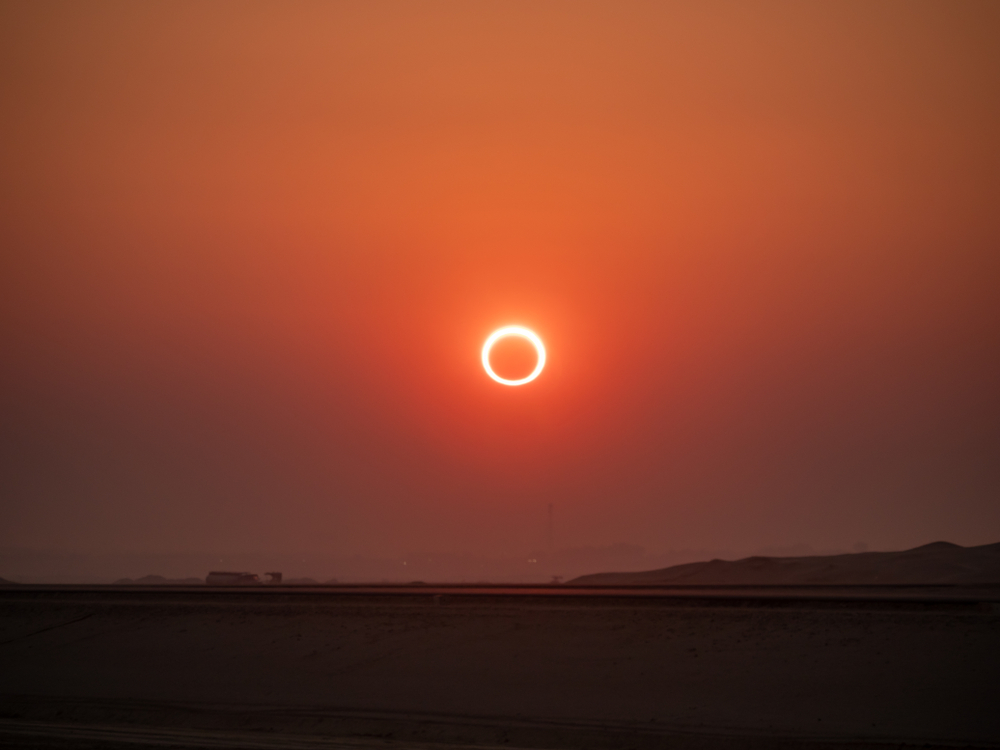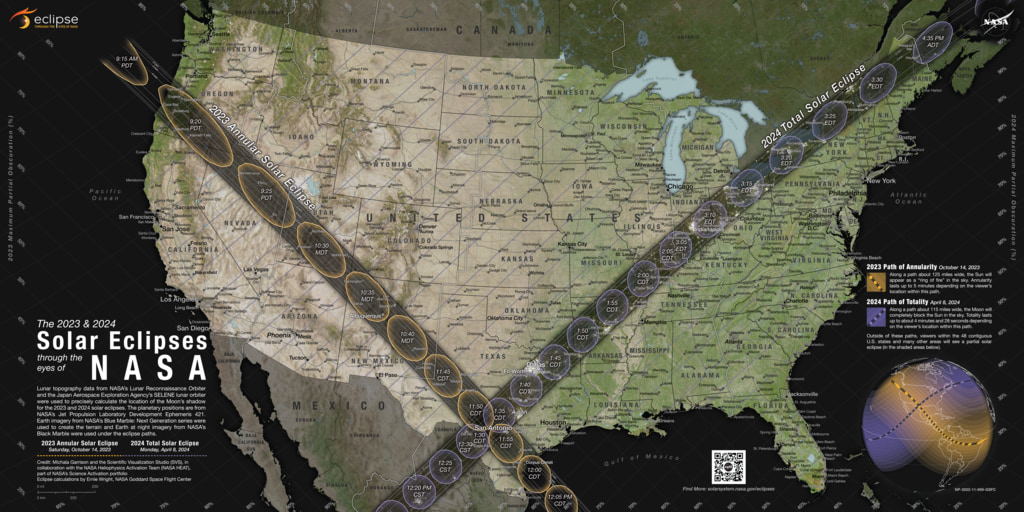Get ready America, for not just one, but two different solar eclipses in the next seven months.
On Oct. 14, an annular solar eclipse will be seen from the Texas Gulf Coast to the Oregon Pacific Coast. At the height of an annular eclipse, the moon passes in front of the sun.
The Oct. 14 eclipse will just be a warm-up for a total solar eclipse on April 8, 2024.
SEE MORE: How to see September's Harvest Moon and the Draconid meteor shower
Viewing solar eclipses requires special glasses
Staring at a solar eclipse not in totality could cause damage to the eye, NASA said. Regular sunglasses also are insufficient for looking at solar eclipses.
NASA said solar eclipse glasses should be marked with ISO 12312-2 on them to confirm they are safe for usage during a solar eclipse.
American Paper Optics CEO John Jerit said the solar eclipse glasses his company makes are ISO 12312-2 certified.
"It means that we've sent it to a lab, we had the filters checked, the construction checked on it and we have a certificate saying that the glasses are safe and have been manufactured safely," Jerit said.
He said the back of his glasses have safety instructions on them for users.
"The ISO standard deals with the amount of blockage that these filters do, and it's a black polymer with a silver coating on it," he said. "So they block harmful ultraviolet and infrared rays so that you can safely look at the sun."
SEE MORE: Exoplanet 120 light-years from Earth has building blocks for life
Annular eclipse to serve as 'appetizer'
With the first of two major solar eclipse events occurring about six months apart, Jerit has been busy in preparation. He said the company has sold thousands of eclipse glasses for major events coinciding with the eclipses.
Even though the October solar eclipse won't be a total one, it will still be spectacular.
"We started a couple of years ago to get ready for the annular eclipse," he said. "It's a warm-up act, as we'd say, like an appetizer, and then the big one April 8th, 2024."

The last time the U.S. had a solar eclipse of this magnitude was in 2017. For that, Jerit's company sold over 45 million solar eclipse glasses. He said he has already sold 35 million glasses in connection to October's and April's solar eclipses.
He said groups in Albuquerque, New Mexico, and Eugene, Oregon, have purchased thousands of his solar eclipse glasses for large viewing events.
The good news for consumers is that solar eclipse glasses purchased for next month's annular eclipse will remain good for the April eclipse as long as they are properly stored, Jerit said.
"You don't want to get them scratched, torn or punctured," he said. "It's perfectly fine to use them for both events."
SEE MORE: Massive star offers new details on the most magnetic objects in space
Why now might be a good time to prepare for April's eclipse
About 32 million Americans live in the path of totality for the April total solar eclipse, which could make it one of the most viewed total solar eclipses in U.S. history.
For the most recent total solar eclipse in 2017, about 12 million Americans lived in the path of totality. For that solar eclipse, glasses were hard to come by online.
Jerit said his company still had a stock of glasses, but a number of other companies had run out.

With more people in the path of totality, demand could be even higher this time around.
"This is a big deal, but I think buying early one will save you money to get it there on time," Jerit said. "You won't be paying for expedited shipping and you'll be prepared and you can just relax and have a great time."
Not only will millions of Americans be able to see the total solar eclipse from their residences, states are expecting a number of tourists to come view the total solar eclipse.
Officials from Visit Indiana told Scripps News they're expecting 600,000 visitors due to the solar eclipse. Hotel reservations in northeast Ohio are hard to come by as the total solar eclipse will last several minutes just west of Cleveland.
A small area of Texas northwest of San Antonio will not only have an opportunity to see a total solar eclipse, but will also see the peak of next month's annular eclipse.
“This will be a historic event for our community, and the economic impact will be extraordinary,” City of Kerrville tourism and event coordinator Rain Thoresen said. “Expecting such a large number of visitors can be a little overwhelming, but we are working to ensure our community is ready and excited."
What is the difference between the two eclipses?
At the height of an annular eclipse, the moon passes in front of the sun. Because of the moon’s distance from Earth, the sun will not be fully eclipsed, instead giving off a halo around the moon. The moon will fit fully within the sun in a swath from Texas to the Oregon coast.
For April's total solar eclipse, the sun will be completely covered by the moon. Residents along a 100-mile-wide swath from the Texas/Mexico border all the way up to Maine can see the total solar eclipse — weather pending, of course.

Dallas, Indianapolis, Cleveland and Buffalo will be among the areas to experience a total solar eclipse. Most of the rest of the U.S. will have a partial solar eclipse. Cities like Boston, New York and Philadelphia will have over 80% of the sun blocked at its peak.
Likewise, most of the U.S. will be able to view next month's eclipse partially, with the moon blocking some of the light from the sun.
Trending stories at Scrippsnews.com



